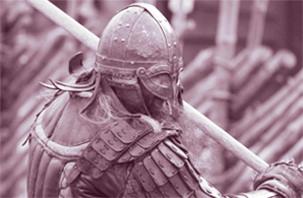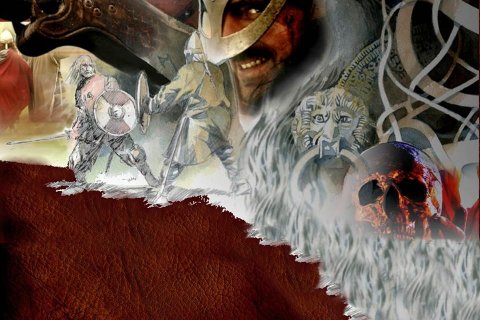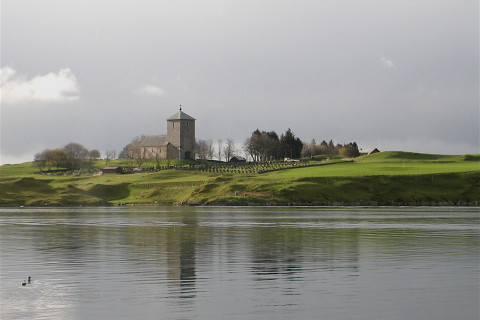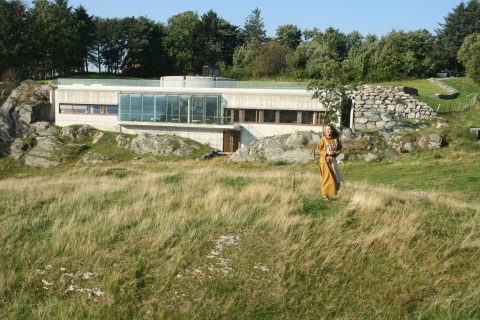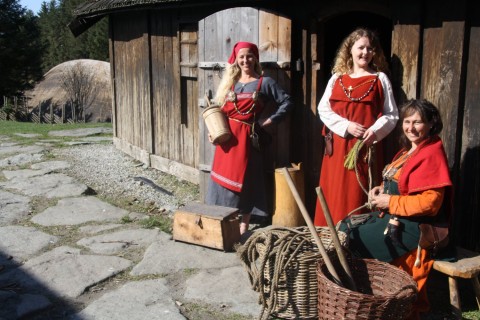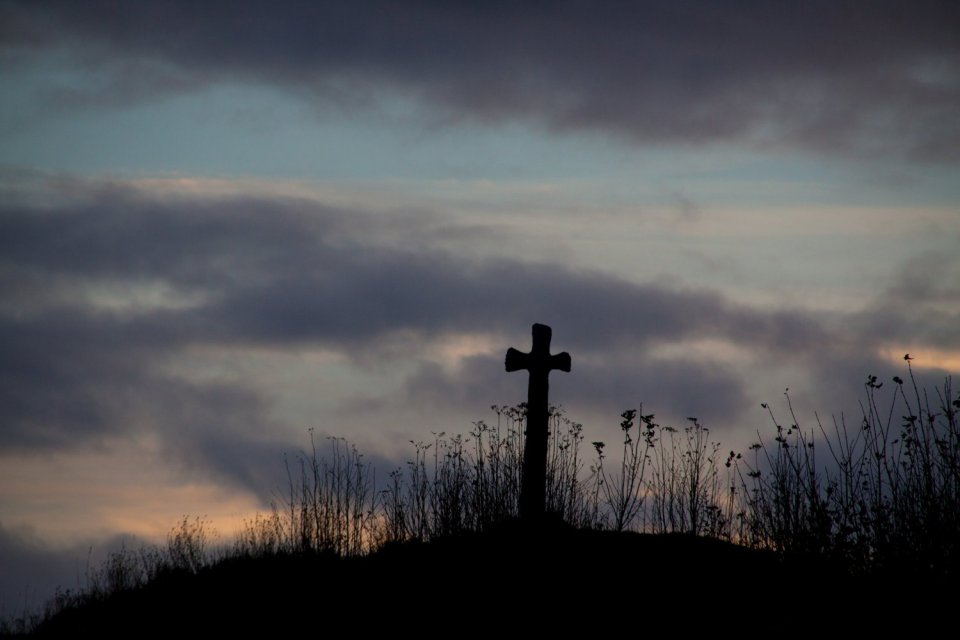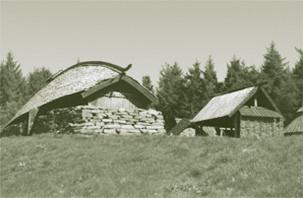Eric Bloodaxe
Text: Marit Synnøve Vea
Eiríkr blóðøx (885 – 954) King of Norway from about 931 – 935
The Saga claims that Harald Fairhair had many wives and many children. When he married Ragnhild the Migthy, daughter of the Danish king Erik. It is told that Harald put away nine of his other wives.
“Harald, of noblest race the head,
A Danish wife took to his bed;
And out of doors nine wives he thrust, —
The mothers of the princes first.
Who ‘mong Holmrygians hold command,
And those who rule in Hordaland.
And then he packed from out the place
The children born of Holge’s race.”
(Saga of Harald Fairhair)
Harald and Ragnhild had one son called Eric, later nicknamed Blood-axe. Eric was fostered in the house of the herse Thorer at Svanøy in the Fjord district of Sogn.
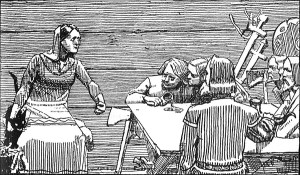
The Saga claims that Eric was influenced by his wife Gunnhild who was a strongheaded woman. “Gunnhild provokes here sons to take revenge”. Ill. C. Krogh)
Eric – Harald’s most beloved son
Eric was the most beloved and honoured by King Harald of all his sons. When Eiric was twelve years old, King Harald gave him five long-ships. He used these to go on Viking expiditions. First he went eastward, and was in the Baltic, Denmark, Friesland, and Saxland for three years. He then sailed out into the West sea and spent four years plundering in Scotland, Bretland and Ireland.
Snorri Sturluson tells this about Eiric:
Eirik was a stout handsome man, strong, and very manly,—a great and fortunate man of war; but bad-minded, gruff, unfriendly, and silent. (Saga of Harald Fairhair)
Eric and Gunnhild
Snorri Sturluson tells that Eric Blooaxe was married to Gunnhild, daughter of Ossur Tote from Haalogaland in Northern Norway. The saga goes on to tell that Eric was much influenced by his wife who was “…the most beautiful of women,—clever, with much knowledge about magic, and lively; but a very false person, and very cruel in disposition.”
The earliest saga Historia Norwegiæ, however, tells that Gunnhild was the daughter of Gorm inn Gamli (‘the Old’), king of Denmark and sister of Harald Bluetooth. Taken into consideration the support her sons later got from the Danish king, this version is probably more in line with the truth
Eric becomes high king
When King Harald was fifty years of age he divided the country among his sons and gave them all the title of king. He was still, however, their superior as high king of Norway.Eric Bloodaxe expected to be high king over all his brothers and King Harald intended he should be so; and the father and son lived long together
When King Harald was about eighty years of age he brought his son Eirik to his high-seat, and gave him the power and command over the whole land. His brothers was ill pleased with this, and when Harald died, Eric killed several of them.
The Nickname Bloodaxe
The chronicler Agrip says that Eric got his nickname because he killed five of his brothers.
Fagerskinna tells that the nickname is related to his Viking raids
Eric Bloodaxe in power of South Western Norway
Primarily Eric’s power base was in Harald’s core area in Western Norway.
In particular bishop Birkeli points to that Eiric must have had special strong ties to Avaldsnes.
Erik Bloodaxe becomes the last Scandinavian king of York/Jorvik
Eric Bloodaxe was not liked by the people of Norway, and when his youngest brother Haakon the Good, returned home from England, Eric fled the country. Eric crossed the North Sea and harried in Scotland and England. Finally the English king, probably Athalstan, offers Eric Northumbria as a fief. Eric accepts and let himself be baptized .
Snorri says:
Athelstan, the king of England, sent a message to Eirik, offering him dominions under him in England; saying that King Harald his father was a good friend of King Athelstan, and therefore he would do kindly towards his sons. Messengers passed between the two kings; and it came to an agreement that King Eirik should take Northumberland as a fief from King Athelstan, and which land he should defend against the Danes or other Vikings. Eirik should let himself be baptized, together with his wife and children, and all the people who had followed him. Eirik accepted this offer, and was baptized, and adopted the right faith.
Northumberland is called a fifth part of England. Eirik had his residence at York, where Lodbrok’s sons, it was said, had formerly been, and Northumberland was principally inhabited by Northmen. Since Lodbrok’s sons had taken the country, Danes and Northmen often plundered there, when the power of the land was out of their hands. Many names of places in the country are Norwegian; as Grimsby, Haukfliot, and many others.
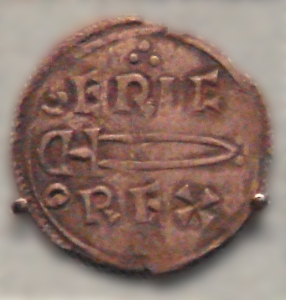
Coin minted during Eric’s reign in Northumbria (952 – 954) On the coin we can read “EIRIC REX”. Photo British Museum
Coins with Eric’s name in York
Eirik’s rule of Northumbria is also corroborated by numismatic evidence. There are found 31 coins minted at York which bear the inscription of Eric’s name.
Egil Skallagrimson erects a níðstöng aginst Eric and Gunnhild
While Eric and Gunnhild still were in Norway, Egil Skallagrimson, well-known Icelandic Viking and skald, killed one of Gunnhilds relatives; Bárðr of Atley. This caused great hostility between him and the royal couple, and before Egil fled the country, he killed their son Ragnald (Rögnvaldr Eirikssen), and erected a níðstöng or “spite-post” against them.
“And when all was ready for sailing, Egil went up into the island. He took in his hand a hazel-pole, and went to a rocky eminence that looked inward to the mainland. Then he took a horse’s head and fixed it on the pole. After that, in solemn form of curse, he thus spoke: ‘Here set I up a curse-pole, and this curse I turn on king Eirik and queen Gunnhilda. (Here he turned the horse’s head landwards.)
This curse I turn also on the guardian-spirits who dwell in this land, that they may all wander astray, nor reach or find their home till they have driven out of the land king Eirik and Gunnhilda.”
This spoken, he planted the pole down in a rift of the rock, and let it stand there. The horse’s head he turned inwards to the mainland; but on the pole he cut runes, expressing the whole form of curse.“ – (Egils Saga, transl. W. C. Green)
When Erik and Gunnhild were living in England, Egil shipwrecked on a nearby shore and came before Eric, who sentenced him to death. Before the execution Egil composed a poem (ON drápa) in Eric’s praise in the dungeon during the night, and when he recited it in the morning, Eric gave him his freedom and forgave any vengeance or settlement for the killing of his son Ragnald. This famous poem is called Höfuðlausn or the “Head’s Ransom”
Death of Eric Bloodaxe
When Athelstan dies, Eiric came into conflicts with his successor Eadred. Eric is killed in the battle of Stainmoor in 954. There are indications that he then was on his way to Viking allies in Scotland or Ireland.
Even if Eric let himself be baptised, he was probably not a true Christian. Fagerskinna claims that Gunnhild commissions the poem Lay of Eric (ON Eiríksmál) to be made in commemoration of Eric’s death. This poem tells about how splendid Eric is welcomed by Odin when he arrives in Valhalla. (ON Valhöll, “hall of the slain”)
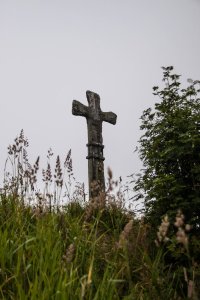
The stone cross at Gard in Haugesund.
According to local tradition this was erected in memory of Eric Bloodaxe. (Photo Cathrine Glette)
ÓTHIN:
“What dreams be these, now? Methought that ere daybreak
I got Valholl ready to make room for warriors;
I waked the einheriar, asked them to rise up,
to put straw on benches, and to rinse the beer-jugs;
and the valkyries, to deal wine out as though a warrior drew nigh.
“Lords from man-home are to be looked for,
high-born and hardy, which my heart gladdens.
“What thunders, Bragi,as though thousands stirred,
or whelming hosts?”
BRAGI:
“Crack all boards of the benches as though Baldr were coming
back to Óthin’s beer-hall.”
ÓTHIN:
“Of witless words shalt beware, wise Bragi,
for full well thou wotst:
’t is Eric this heralds, who to us is wending,
the earl, into Óthin’s hall.
“Sigmund and Sinfiotli, leave your seats, ye heroes,
and go forth to greet the king!
Bid him enter in, if Eric it be:
him I have hopes to see.”
SIGMUND:
“Why of Eric, rather than of another?”
ÓTHIN:
“Because in many a liege-land this lord hath warred
and borne a bloody sword.”
SIGMUND
“Why, then, didst rob him of victory, since valiant thou thought’st him?”5
ÓTHIN:
No one knoweth—
looks the grey wolf (grimly) toward the gods’ dwellings.”
SIGMUND:
“Hail to thee, Eric, here thou art welcome!
wise war-lord, in hall.
This fain would I know:who be following thee
of athelings, from the edge-fight?”
ERIC:
“Kings five there are, them all I shall name thee:
am I the sixth myself.”
(Norse Poems, Lee M. Hollander 1936)
The stone cross at Gard
According to local tradition the stone cross at Gard was erected in memory of Eric Bloodaxe.
Also bishop Birkeli writes that this cross probably is connected with Eric and his sons.
Others, like prof. Knut Helle thinks this cross, and four others made of Hyllestad stone, are erceted to mark an early Christian royal officialdom.
Battle of Blood Heights
In 953, a Danish/Norwegian army led by Eric Bloodaxe’s sons sailed up the strait of Karmsundet. They landed at Avaldsnes where they fought a bloody battle against their uncle Haakon the Good amongst the Bronze Age mounds at Blood Heights.
The chronicler Agrip relates that three of Eric Bloodaxe’s sons died in this battle, but Snorri only mentions Guttorm Eiriksson.
One of the Bronze Age burial mounds are still named Guttorm’s mound because people believed Guttorm was buried inside it.
Beacuse of this harrowing battle, the heights have been called Blood Heights.
Back

